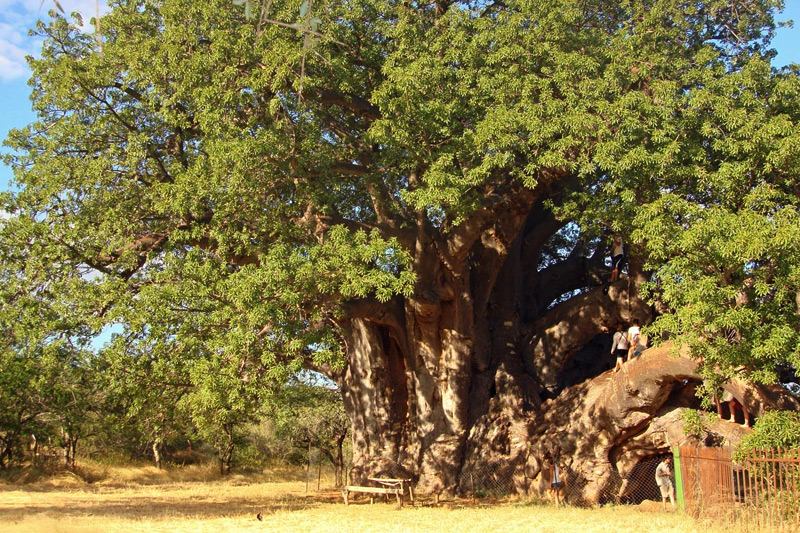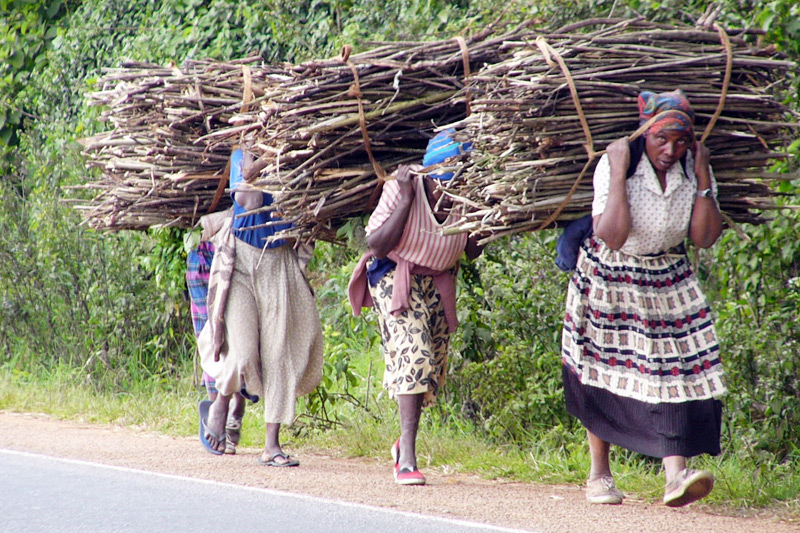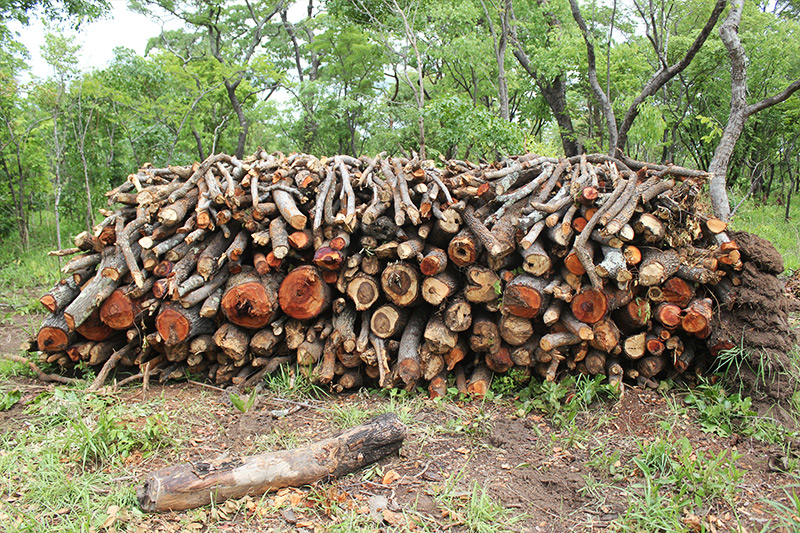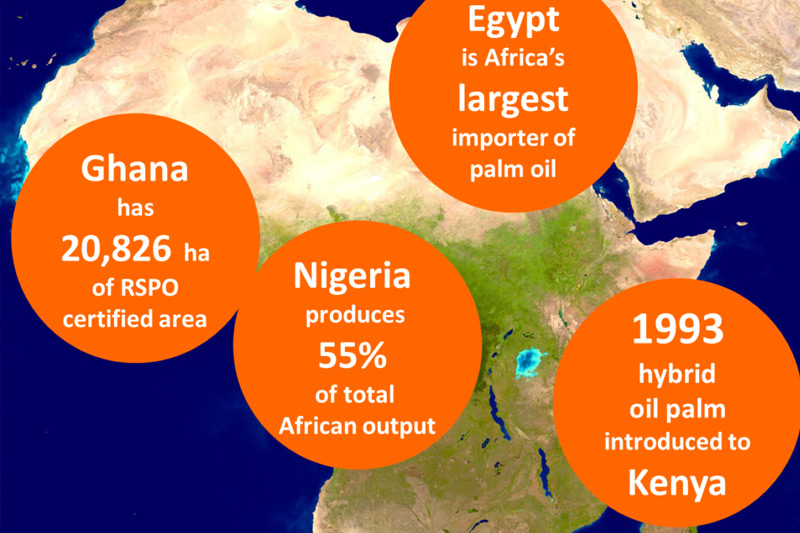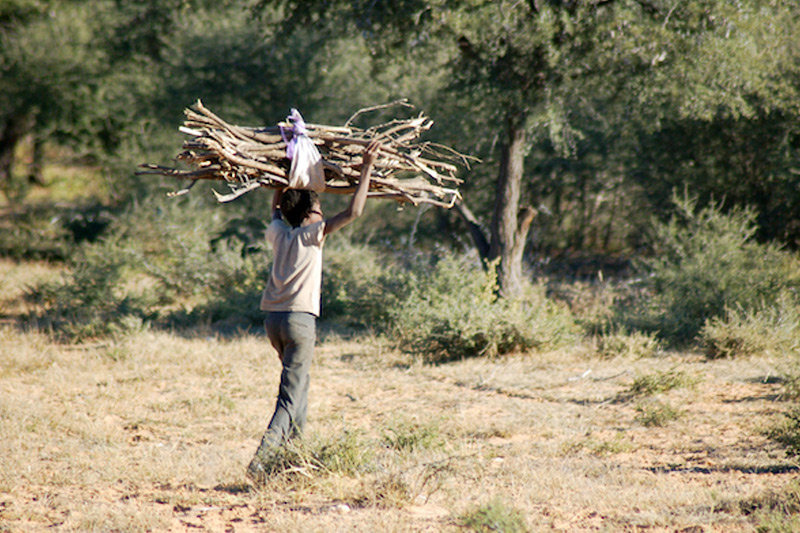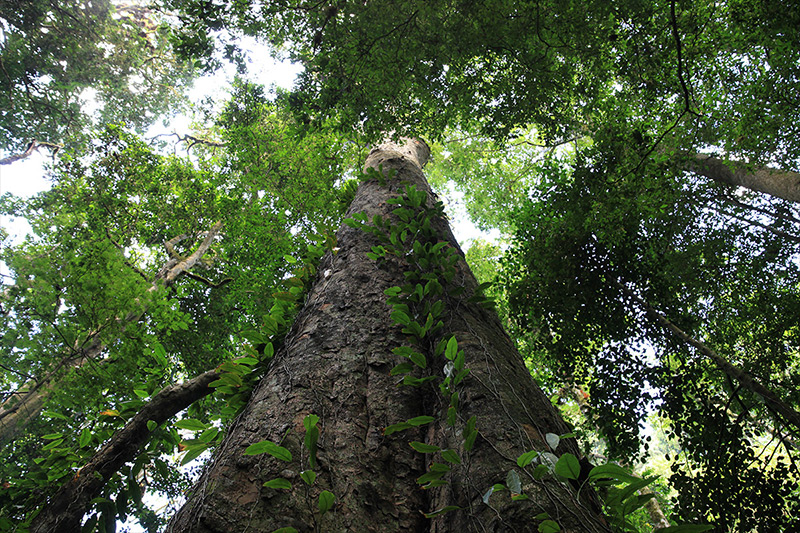
The colossus in Tanzania has matched Africa’s previous tree-height record established by a specimen of the introduced Sydney blue gum (Eucalyptus saligna) in Limpopo, South Africa, which died in 2006.
The tallest known tree in Africa, on Mount Kilimanjaro, measures 81.5 meters (267 feet) tall
This Entandrophragma excelsum tree in Tanzania has matched Africa’s previous tree-height record established by a specimen of the introduced Sydney blue gum (Eucalyptus saligna) in Limpopo, South Africa, which died in 2006.
The tallest living tree in the world is a coast redwood (Sequoia sempervirens), named Hyperion after a person in Greek mythology. The tree is no less than 115.72 meters (379.7 feet) tall! This enormous tree was discovered only in August 2006 in a remote part of Redwood National Park, California by naturalists Chris Atkins and Michael Taylor. Source
The oldest known tree in Africa is the baobab (Adansonia digitata) west of Gravelotte
The girth of African baobab tree is not known. Its height is not known. This tree was planted around the year 50 BC ± 500, which makes it around 2067 ± 500 years old. Gravelotte is a small town situated in the east of the Limpopo province of South Africa.
The oldest known living tree in the world is a Bristlecone Pine over 5,000 years old. Prior to 2012, the oldest known tree in the world was thought to be Methuselah at 4,848 years. In 2012, a 5,066-year-old Great Basin bristlecone pine tree was found in the same region of White Mountains, California. The exact locations of the world’s tallest and oldest trees are kept top secret to avoid tourist crowds damaging them and their surroundings.
Known as the largest tree baobab tree in South Africa, the Sagole Baobab has a trunk diameter of 10.47 meters (34.35 feet)
The Sagole Baobab (Adansonia digitata or Sagole Big Tree) is the largest baobab tree in South Africa. It is located east from Tshipise, in Vendaland, Limpopo Province. This is not the stoutest tree in South Africa as two other baobabs, the Glencoe and Sunland Baobabs, have larger diameters. Sagole Baobab though has the largest size overall
The tree called "General Sherman" is not only the biggest giant sequoia, but it is also the biggest tree in the world. He is 83.8 meters (274.9 feet) tall, his girth at breast height is 24,10 m (79 feet) (near the ground it is 31.3 meters or 102.6 feet).
Nearly 1/4 of Africa’s land is covered with forest
The Congo Basin is home to one of the world’s largest tropical rainforests – second only to the Amazon. It reaches across six countries in central and west Africa. Humans have inhabited the forests of the Congo Basin for tens of thousands of years. Today, the Congo Basin provides food, medicine, water, materials and shelter for over 75 million people.
Over 8,000 plant species have been discovered in the rainforests of Africa
African rainforests can be found spread across east, central and west Africa and cover over 2.2 million square miles (3.6 million square kilometers). Approximately 3/4 of Africa's rainforests are located in central Africa. Even though rainforests cover less than 2% of the earth’s total surface area, about 50% of the plants and animals on earth live there. In fact, 1,500 flowering plants, 750 species of trees, 400 species of birds and 150 species of butterflies can be found in 4 square miles of rainforest (Source).
Wood accounts for 27% of the total primary energy supply in Africa
In Africa, wood accounts for over 1/4 of the primary energy supply. An estimated 70-90% of Africa's population uses fuelwood for cooking. Firewood and brush supply approximately 52% of all energy sources in Sub-Saharan Africa.
Globally, wood accounts for about 45% of the world's renewable energy supply and provides the world with more energy than solar, hydroelectric or wind power.
Fuel wood in sub Saharan African countries is consumed up to 200% times more than the annual growth rates of the trees
While deforestation in other parts of the world is mainly caused by commercial logging or cattle ranching the leading causes in Africa are associated with human activity. This is causing deforestation, lack of timber resources and loss of habitat for the species living in it.
Deforestation is affecting Africa at twice the world rate. According to the University of Pennsylvania African Studies Center, 31% of Africa's pasture lands and 19% of its forests and woodlands are classified as degraded. Africa is losing over 4 million hectares (about 9.9 million acres) of forest per year, which is twice the average deforestation rate for the rest of the world. (Source). In several Sub-Saharan African countries, the rate of deforestation exceeded the global annual average of 0.8%.
Palm Oil is the primary cooking oil in Africa
As familiar as olive oil or corn oil in North America, palm oil is the most widely-used vegetable oil worldwide. It's found in everything from soap and shampoo to cereal, bread and cosmetics. Nigeria is Africa's largest producer of palm oil and fifth largest in the world in 2015. The problem with the the palm oil industry in Africa is that the government is signing over land to companies, causing people to lose access to their farmland. As much as 22m hectares (54m acres) of land in west and central Africa could be converted to palm plantations over the next five years (Source). Because of this industry, food insecurity and pollution have gone up and families have been severely inconvenienced in their daily lives. For example, a woman fetching water for her family may spend two hours where it used to take 30 minutes.
30 million jobs are created by forest based activities in developing countries
Like other branches of the agriculture, forestry is an important field. Forests are a raw material source, a local employment source and often the national income source for a country. The Sub-Saharan Africa charcoal sector alone employs an estimated 7 million people. Almost 900 million people, mostly in developing countries, are engaged in the wood-energy sector. Forests can be used for lumbering, which can provide income to that country.
But, in the modern world, the growing global population increases the demands of forest products. This means that forests are at high risk of deforestation and degradation.

Read Rays of Hope
Learn more about Catholic Sisters transforming poor, rural communities across Africa in our FREE Rays of Hope ebook.
Read It Now »
In the modern world, the growing global population increases the demands of forest products. This means that forests are at high risk of deforestation and degradation.
Dangers of Deforestation in Africa
Deforestation is affecting Africa at twice the world rate. According to the University of Pennsylvania African Studies Center, 31% of Africa's pastures and 19% of its forests are classified as "degraded." Africa is losing over 4 million hectares (about 9.9 million acres) of forest per year, which is twice the average deforestation rate for the rest of the world. (Source). In several Sub-Saharan African countries, the rate of deforestation exceeded the global annual average of 0.8%.
Forests are an essential part of the life on Earth and are important for the balance of biological diversity. Trees gather and release the water on the earth and maintain the flora and fauna habitat balance.They also fulfill the demands of the human beings by providing shade, shelter, and refreshment including clean air and water.
Forests are the complex living community of trees which provide a home and shelter to animals. The soil beneath the forest gives home to a variety of invertebrates, fungi and bacteria, all who play a significant role in balancing the nutrient cycle. Trees help our soil remain healthy by reducing soil erosion and by creating a soil climate suitable for microorganism to grow.
Trees in the forest also help to reduce global warming by reducing gases that deplete the ozone layer such as methane and carbon dioxide. These gases cause air pollution and that along with changes in rainfall, water pollution and land pollution can bring about climate change. Forests and trees help to mitigate the impact of climate change, particularly in and around uban areas in Africa. Learn more about the affects of climate change in Nigeria.
The International Day of Forests was established in the year 1971 at the 23rd General Assembly of European Confederation of Agriculture. It was decided to be celebrated as an annual event celebration on 21st of March by the United Nations Food and Agriculture Organization. This event was originated to give support to raising public awareness about the importance of the forests.
On the International Day of Forests, people are brainstorming ways to incorporate the forests into future climate change strategies. Loss of the forests also means loss of habitat for the animals and species that live in the the forest. Deforestation imbalances the natural climate by increasing carbon dioxide and decreasing the oxygen percentage. This can lead to global warming.
You can learn more about the International Day of Forests on the United Nations website.
"One may wonder what is so special about the forests. The answer is very simple; in Genesis we read that whatever God created saw it to be very good... God crowned man as the master of His creation. Hence man should take care of nature and nature will take care of man." -Sr. Brigdet Kanyanta, SLDI Alumna, Zambia
Gen 1:11-12: Then God said, let the earth bring forth vegetation, every kind of plant… and so it happened the earth brought forth every kind of plant.
Combating Deforestation in Africa
Interested to know more? Learn how sisters are combating deforestation in sub-Saharan Africa and how you can help.
Sources
- United Nations International Day of Forests 21 March
- Conserve Energy Future - 51 Breathtaking Facts About Deforestation
- Africa's tallest tree measuring 81m found on Mount Kilimanjaro
- Monumental Trees - Baobab
- Wondermondo - Sagole Baobab
- WWF - Congo Basin
- SPOTT - Palm Oil in Africa
- CNN - The vegetable oil that fuels a $50 billion business
- The Guardian - Palm oil boom: companies must clean up their act in Africa
- Wikipedia Africa | Deforestation | Adansonia digitata | Entandrophragma excelsum




